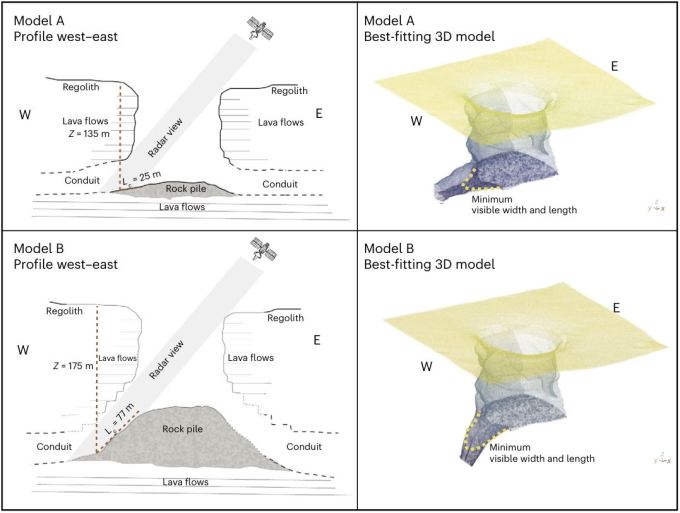Scientists have identified what they believe is an accessible tunnel or cave on the moon. Such a feature, if real, may well define years of development by startups, governments and space companies aiming to create a lasting lunar colony.
Italian astronomers led by Leonardo Carrer and Lorenzo Bruzzone, working with Capella Space and JHUAPL, analyzed data collected by the Lunar Reconnaissance Orbiter in 2010. Specifically, its radar imagery of the surface, which in one place the team proposes was reflected in such a way that implies the presence of “a subsurface cave tens of meters long” — but potentially much larger.
It’s still at the bottom of a pit around 100 meters deep, but we’ll figure that part out later. What matters here is that we appear to have discovered a highly stable (otherwise it would have collapsed some time in the last few million years) moon cave that could serve as a base for lunar operations. Their findings are published in Nature Astronomy.
You may well ask: Why would we bother hiding in some ancient lava tunnel? Don’t we want to just make a surface habitat?
That’s certainly what we envision from science fiction, yes, but the reality is that the moon’s surface is quite an inhospitable place. With no ionosphere, it has no protection from solar or cosmic radiation, and its pocked surface shows how frequently it is bombarded by meteorites large and small, which are not slowed or burned up in an atmosphere. The temperature also varies from deep-space low to dangerously hot.
These and other factors mean that any surface dwelling would need to be extremely robust, and even so it would face serious risk over time. For this reason lunar cave systems have often been proposed as alternatives to building the whole thing ourselves.
Nestled scores of meters below the surface’s fluffy (yet sharp) regolith and the harder layers beneath that, these tunnels are insulated from temperature fluctuations, protected from radiation and inaccessible to wandering space rocks. It’s just that until recently, such tunnels have been largely theoretical. We deduce their existence from pits like this one, which suggest a network of hollow tubes, but this paper is the first time anyone appears to have directly observed one (even if it was sort of by accident).
What this means for the space industry is that theory has become reality: The possibility of designing a habitation within a lunar tunnel is a reasonable proposition and one that is likely to be pursued with vigor and much funding after this. The location is even good: Mare Tranquillitatis, where Apollo 11 touched down (some distance away; it’s a big mare).
After the historic success of Intuitive Machines last year with the first-ever private moon landing, don’t be surprised if we see private and public efforts to reach and explore this cave specifically, or to establish the presence of others.
Not only that, but plans for lunar habitats and long-term presence are being drafted right now — and all of these plans must now be reevaluated in the context of a known and accessible moon cave. If NASA is going to spend $20 billion on something it hopes will last decades, it’ll want to get it right the first time — and this could be the next big notion in space.
As such, you can expect a wave of research and startups aimed at, if not outright troglodytic, at least cave-adjacent lunar tech. Lunar additive and robot manufacturers will show how they can shore up walls; solar providers will demonstrate drilled conduits or long-distance power transmission (more practical on the moon than here, actually). Robotic exploration and excavation will get a second wind. The lunar rover contenders will add bigger headlights.
Though the discovery of the moon cave is a shot in the arm for serious lunar habitat thinkers, builders and funders, it’s far from a sure thing. The cave is at the bottom of a pit, after all, meaning access will require excavation or infrastructure. Its dimensions and conditions aren’t known; it could easily be too small, crowded with rubble or otherwise impractical for habitation. But no one really expected the first tunnel we found to be a home run; its very existence changes the game, acting as a starting gun for the race to find the best moon cave in which to settle future lunar colonists.


